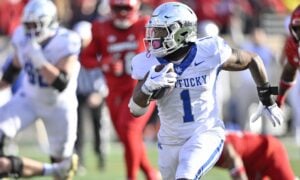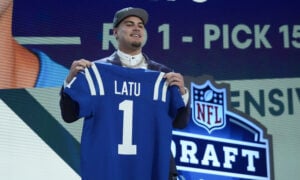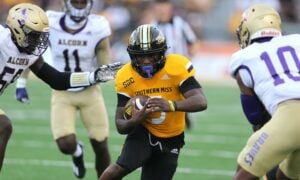Tyler Boyd: The Dynasty Wide Receiver You Need to Buy
Do you ever think back over your time playing dynasty football and kick yourself over the missed opportunities you had? Are you still kicking yourself for not acquiring Davante Adams when he was viewed as a bust before his third-year breakout? How about Adam Thielen? He was free on waivers in most leagues before his meteoric rise.
Every year, we are presented with opportunities to take a flier on a player or get him cheaply in a trade. This year is no different. So, who should you be aggressively acquiring in dynasty? I think a little back story is required.
Over the course of 2018, I was building a Dynasty WR model in my spare time. It considers a player’s age, experience, college profile, and how they performed in various predictive stats to give each player an overall score. I finally completed it around October and released it to the Twittersphere. I was immediately criticized for having JuJu Smith-Schuster as a top five dynasty receiver and Antonio Brown barely inside the top ten. Well, Mr. Big Chest and his blonde mustache are now in Oakland and according to the latest DLF startup ADP, Smith-Schuster is being drafted as a top-five wideout and Brown is barely in the top ten.
I’m not saying my model 100% predicts the future (although it is debated), but so far in its young life (small sample size, I know), I would say that it has fared well. With all that said, I now want to focus on the receiver my model is screaming at me to buy. If you follow me on Twitter, @DeWitt_Dynasty, you likely already knew this article was coming. For those of you who do not follow me and therefore enjoy losing, it is Tyler Boyd.
So, why Tyler Boyd? This won’t come as a shock to my Twitter followers, but for the rest of you, prepare for a shock. At the conclusion of the 2018 season, my model had Boyd as the WR9 in dynasty. Yes, you read that right; my model has Tyler Boyd as a top ten dynasty WR. Now I know what you’re thinking: “You’re an idiot and your model is broken”. While the former may be true, this article is going to lay out the reasons why you need to take the latter seriously.
[am4show have=’g1;’ guest_error=’sub_message’ user_error=’sub_message’ ]
College Profile
Let’s start with Tyler Boyd as a college receiver. In the interest of transparency, with my model, the more years of experience in the NFL a receiver has, the less his college profile matters. In fact, a player’s fourth season is the last year the model considers a player’s college profile when scoring them for dynasty purposes. Since Boyd is entering his fourth season, his college profile barely matters anymore, but it’s still worth looking at in order to make his case for inclusion in the top ten.
When it comes to predicting a player’s future NFL production in terms of their collegiate resume, all that matters predictively is Age-Adjusted College Dominance (which is quantified through College Dominator and Breakout Age) and Draft Capital. Therefore, a collegiate receiver has three boxes he has to check.
Starting with College Dominator, in order to check this box a player needs to cross a 30% threshold. Tyler Boyd’s Dominator was 42.7%, which not only crushes the 30% threshold, but is very impressive for Power-5 receiver. Box checked.
As for Breakout Age, my model checks this box if a player broke out before they were 20.5 years old. In order to “break out’, a player must achieve a College Dominator of 20% or higher in a season. If they achieve this, then their age at the halfway point of their breakout season is used for their Breakout Age. Boyd broke out at 18.8 years old so he easily checks another box.
And finally, we reach Draft Capital. Peter Howard (@pahowdy) has done a great job of breaking down a receiver’s likelihood of breaking out in the NFL based on age and where they were drafted. If you don’t have an FFStatistics subscription, here’s a key takeaway. Wide receivers are much more likely to succeed if they are drafted in the first three rounds of the NFL Draft. So, this is how I determine if a receiver checks this box. Boyd was drafted by the Bengals in the second round in 2016. Again, box checked.
For some context as to how good of a prospect Tyler Boyd was coming out of Pitt, my model would have had him as the WR1 of the 2016 rookie class ahead of Corey Coleman, Laquon Treadwell, Will Fuller, and Josh Doctson. If he were coming out in the 2019 class, he would currently be the WR2 behind only N’Keal Harry. If you haven’t figured it out yet, Boyd was a very good prospect in 2016.
2018 Season
When it comes to what matters for predicting future NFL success, counting stats mean next to nothing. Here are the stats I have found to be the most predictive of a player’s future performance: aDOT, Targets per Game, Target Share, RACR, Receptions per Game, Yards per Game, and PPR Points per Game. All of these can be found on Josh Hermsmeyer’s (@friscojosh) Airyards.com. It’s a great resource, especially for Josh’s stats like RACR. If you are unfamiliar with some of these terms, Josh breaks them down here.
So how did Tyler Boyd do in these categories? Let’s take a look:
- aDOT: 10.1 (#89)
- Targets/Game: 7.7 (#21)
- Target Share: 22% (#21)
- RACR: 0.95 (#27)
- Receptions/Game: 5.4 (#16)
- Yards/Game: 73.4 (#16)
- PPR Points/Game: 15.8 (#18)
When you put all these together into a composite score, Boyd comes out as the WR20 in terms of his 2018 predictive stats. You may be thinking to yourself “How the hell does that make him a top-ten WR?”. Well, it’s a combination of his predictive stats, prospect profile, and age. Take a look at the rest of my model’s top-12 WRs and they look pretty similar to current DLF startup ADP:
- DeAndre Hopkins
- Davante Adams
- JuJu Smith-Schuster
- Odell Beckham Jr.
- Michael Thomas
- Mike Evans
- Tyreek Hill (pre audio tape)
- Antonio Brown
- Tyler Boyd
- Julio Jones
- Amari Cooper
- Stefon Diggs
I would contend that the rest of the top 12, despite some variation, is pretty spot on. Remember, the model called Smith-Schuster being in the top five and Brown being closer to number ten long before it was a consensus opinion. This isn’t just some biased love affair that I have for Tyler Boyd. I was actually just as surprised as you are that the model put him in the top ten. Let’s not just take my model as gospel though. Are there any outside sources that can help fortify the argument?
Additional Proofs
Maybe it’s just the genius in me, but one day I thought to myself: “Man, Tyler Boyd’s career feels a lot like Davante Adams’s career so far.” Now Adams is a much better athlete and is suited to more of an outside role than Boyd is, but both were drafted in the second round, pretty much given up on by the end of their sophomore campaigns, and had breakout seasons in their third year. Let’s see if Boyd’s breakout is legit by looking at his 2018 predictive stats and compare them to Adams’s predictive stats from 2016.

Despite Adams being more of an outside receiver and Boyd being a slot receiver, these two are pretty similar. Adams has a higher aDOT and Boyd has a better RACR (products of their roles), but their opportunity in the form of targets per game, receptions per game, and target share are very close. Another difference stands out in how they produced their fantasy points. Boyd’s came from more yards, whereas Adams’s came from touchdowns (12 for Adams compared to seven for Boyd).
Let’s compare Boyd to another receiver who broke out in 2016, Adam Thielen, who just so happens to also be Boyd’s best comparable player on Player Profiler.

This is also a close comparison. While Boyd had more opportunity and therefore production, these two are very similar in their aDOT and RACR, which again is likely due to their similar roles. The point in all of this is that Boyd’s 2018 breakout looks very similar to the breakouts of Adams and Thielen. While that does not guarantee that Boyd will go on to have a career similar to either player, I will argue that it is a good sign.
What else did Boyd do in 2018? Below are some Pro Football Focus snapshots from Boyd’s season:



Images from Pro Football Focus.
Here are some PFF articles on Boyd:
- Tyler Boyd is one of the league’s best No. 2 receivers
- Tyler Boyd is a top 5 slot receiver in the NFL
Conclusion
Let’s put this all together. Boyd was a great prospect coming out of college, ranks highly in my WR model, was the WR20 in predictive stats, had a breakout season similar to Davante Adams and Adam Thielen, and according to PFF is a top five slot receiver, one of the best number two receivers, was the WR12 in overall grade, and had a very high passer rating when targeted.
Are you not convinced that Boyd has all the makings and indicators of future NFL success? Here’s one more fun tidbit about Boyd: despite 2019 being his fourth season in the NFL, he is actually younger than Marquez Valdes-Scantling, Cooper Kupp, and Kenny Golladay.
So maybe I cannot convince you that Tyler Boyd is a top ten WR in dynasty. That’s ok. Agree to disagree. Regardless, here’s the biggest reason you need to be buying: According to the most recent DLF ADP, Boyd is being selected as the WR29… Yes, that is correct. WR29. That, my friends, is what I like to call a steal. Go get him now for cheap and thank me later.
[/am4show]
- Top Ten Overrated Dynasty Players - January 31, 2020
- Dynasty Injury Impact: Week 14 - December 11, 2019
- Dynasty Injury Impact: Week 11 - November 21, 2019


































































